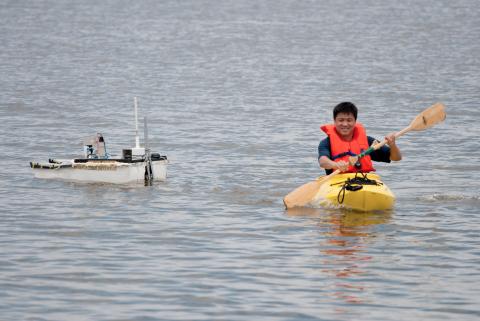One year after the Deep Horizon oil spill disaster, researchersare trying to pinpoint the remnants of the 200 million gallons of crude oilleaked into the Gulf of Mexico. A multi-institution research group led by FuminZhang, an assistant professor in the School of Electrical and ComputerEngineering (ECE) at Georgia Tech, recently performed a 20-day survey usingstudent-developed marine robots at Grand Isle State Park in Louisiana, an areaheavily polluted by crude oil and is still undergoing cleaning efforts.
Joining Dr. Zhang in this collaboration are Professor MichaelMalisoff, a control theorist and mathematician from Louisiana State University,and Professor Mark Patterson, a marine scientist and robotics expert from theCollege of William and Mary; this activity is supported by the National ScienceFoundation. The research goal is to develop robotic surveying methods toprovide a fast response to evaluate the immediate as well as longer termenvironmental impact of the oil spill or future events of a similar nature.
The Georgia Tech team has developed an autonomous boat namedVictoria that successfully performed autonomous surveys over a 300mx100m tidallagoon in the park under various weather conditions. The robotic surveyingmethods provide a low cost and convenient way to collect data in the marshareas that are difficult to access by human-based methods. Large amounts ofdata have been recorded from a crude oil sensor mounted on Victoria, whichindicated an average concentration of suspicious carbon-hydrates at the levelof 20-50 parts per billion. Such concentration, if confirmed to come from crudeoil, is not considered acutely toxic to fish and wildlife, but may have long-termnegative effects that are yet to be understood.
In addition to Victoria, the Georgia Tech team deployed aremotely operated underwater robot named ROV-Beta that has collected water andsediment samples at spots where Victoria sensed high carbon-hydrateconcentrations. The composition of the samples can be further analyzed toidentify the species of the carbon-hydrates. The ROV-Beta has demonstrated thatit is able to collect the samples while keeping humans out of harm’s way.
An autonomous underwater vehicle, the Fetch, developed by theCollege of William and Mary, has been performing autonomous surveys side byside with Victoria. Drs. Zhang, Malisoff, and Patterson have developed acontrol method that has enabled Victoria and Fetch to synchronize their motion.Such cooperative behaviors between different types of vehicles are essentialbuilding blocks toward developing a large scale, mobile sensor network tomonitor and protect a coastal area.
The Georgia Tech team has had greatcontributions from the following ECE and mechanical engineering (ME) graduatestudents: Shayok Mukhopadhyay (ECE), Steven Bradshaw (ECE), Chuanfeng Wang (ME),and undergraduate students Sean Maxon (ECE), Valerie Bazie (ECE), Phillip Cheng(ECE), and Brian Redden (ME). The full list of students who have designed andbuilt Victoria and ROV-Beta can be found at the website of the Georgia Tech-SavannahRobotics-http://gtsr.gtsav.gatech.edu/.
Additional Images

